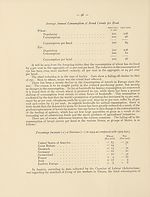Download files
Complete book:
Individual page:
Thumbnail gallery: Grid view | List view

— 95 —
Between 1910-11 and 1920-21, the population of the earth increased from
1,690 millions to 1,813 millions—i.e., by 7 per cent. The population of Europe in the
same period increased from 417 to 451 millions—i.e., by 8 per cent. The change which
has come about in the requirements of Europe is of some interest:
Consumption of Cereals in Europe (excluding Russia).
(In millions of quintals)
1909-1913 1921-1925
Production 1,209 1,027
Excess of imports over exports 237 238
1,446 1,265
In spite of the diminished production, the import of cereals has remained practically
stationary. In other words, an increased population has managed to satisfy its require¬
ments with smaller quantities.
1909-1913 1921-1925
= 100
Consumption of cereals 100 87.5
Population 100 108
Consumption per head 109 81
The consumption of cereals in Europe has decreased therefore by 12.5 per cent,
and the consumption per head of the population by an average of 19 per cent. These
calculations include all forms of cereals.
The situation in regard to individual cereals is as follows:
Consumption of Cereals in Europe (excluding Russia),
(a) Wheat:
Production . . .
Excess of imports
Consumption . .
(b) Rye:
Production . . .
Excess of imports
Consumption . .
(c) Barley:
Production . . .
Excess of imports
Consumption . .
(d) Oats:
Production . . .
Excess of imports
Consumption . .
(e) Maize:
Production . . .
Excess of imports
Consumption . .
(In millions of quintals)
1909-1913 1921-1925
370
123
493
251
7
258
154
43
197
282
19
301
I5i
45
324
148
472
198
13
211
136
15
151
241
11
252
127
52
1909-1913
— 100
96
82
77
84
196
179
9i
Between 1910-11 and 1920-21, the population of the earth increased from
1,690 millions to 1,813 millions—i.e., by 7 per cent. The population of Europe in the
same period increased from 417 to 451 millions—i.e., by 8 per cent. The change which
has come about in the requirements of Europe is of some interest:
Consumption of Cereals in Europe (excluding Russia).
(In millions of quintals)
1909-1913 1921-1925
Production 1,209 1,027
Excess of imports over exports 237 238
1,446 1,265
In spite of the diminished production, the import of cereals has remained practically
stationary. In other words, an increased population has managed to satisfy its require¬
ments with smaller quantities.
1909-1913 1921-1925
= 100
Consumption of cereals 100 87.5
Population 100 108
Consumption per head 109 81
The consumption of cereals in Europe has decreased therefore by 12.5 per cent,
and the consumption per head of the population by an average of 19 per cent. These
calculations include all forms of cereals.
The situation in regard to individual cereals is as follows:
Consumption of Cereals in Europe (excluding Russia),
(a) Wheat:
Production . . .
Excess of imports
Consumption . .
(b) Rye:
Production . . .
Excess of imports
Consumption . .
(c) Barley:
Production . . .
Excess of imports
Consumption . .
(d) Oats:
Production . . .
Excess of imports
Consumption . .
(e) Maize:
Production . . .
Excess of imports
Consumption . .
(In millions of quintals)
1909-1913 1921-1925
370
123
493
251
7
258
154
43
197
282
19
301
I5i
45
324
148
472
198
13
211
136
15
151
241
11
252
127
52
1909-1913
— 100
96
82
77
84
196
179
9i
Set display mode to:
![]() Universal Viewer |
Universal Viewer | ![]() Mirador |
Large image | Transcription
Mirador |
Large image | Transcription
Images and transcriptions on this page, including medium image downloads, may be used under the Creative Commons Attribution 4.0 International Licence unless otherwise stated. ![]()
| League of Nations > Economic and financial section > Agricultural crisis > Volume 1 > (97) |
|---|
| Permanent URL | https://digital.nls.uk/190903911 |
|---|
| Shelfmark | LN.II.2/2.(35) |
|---|---|
| Attribution and copyright: |
|
| Shelfmark | LN.II.2/2.(35-35) |
|---|---|
| Shelfmark | LN.II |
|---|
| Description | Over 1,200 documents from the non-political organs of the League of Nations that dealt with health, disarmament, economic and financial matters for the duration of the League (1919-1945). Also online are statistical bulletins, essential facts, and an overview of the League by the first Secretary General, Sir Eric Drummond. These items are part of the Official Publications collection at the National Library of Scotland. |
|---|---|
| Additional NLS resources: |
|

